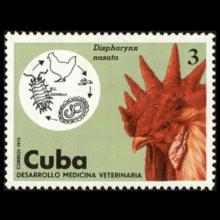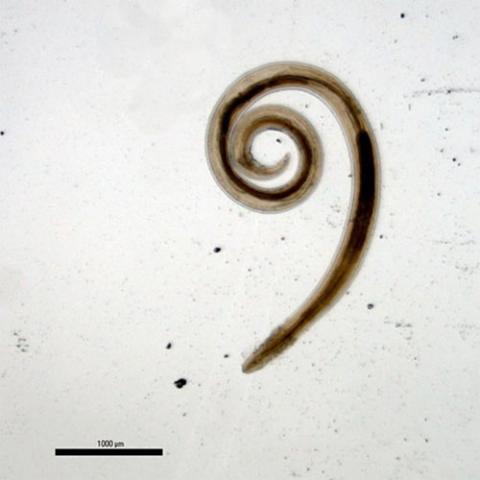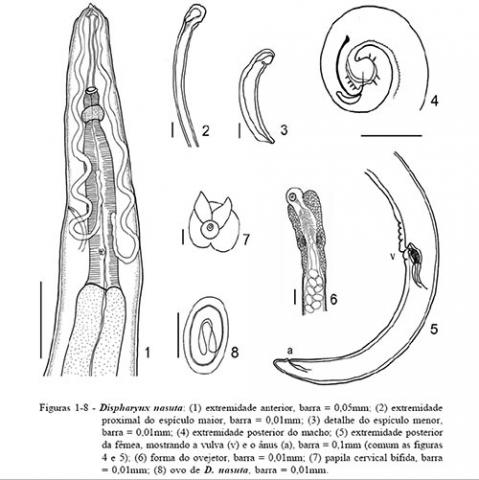NAMES
TAXONOMY
Cuba
Issued:
Stamp:
Acuaria spiralis
Cuba
Issued:
Stamp:
Acuaria spiralis
Cuba
Issued:
Stamp:
Acuaria spiralis
Genus species (Animalia): Acuaria spiralis
Acuaria is a genus of parasitic roundworms (which includes the species Acuaria spiralis) that infects numerous domestic birds (chickens, turkeys, pigeons, guinea fowls, etc.). These worms are not as frequent as other gastrointestinal roundworms of poultry (e.g. Ascaridia spp, Capillaria spp, Heterakis spp), but prevalence can be as high as 50%.
The most relevant species for poultry are:
- Acuaria spiralis = Dispharynx spiralis = Dispharynx nasuta = Synhimantus nasuta, found mainly in America, Africa and Asia.
- Acuaria hamulosa = Cheilospirura hamulosa, known also as the gizzard worm, found mainly in Africa (up to 50% prevalence), but reported also in America and Asia.
These worms do not affect dogs, cats, cattle sheep, goats, horses or swine.
The disease caused by Acuaria worms is called acuariasis, acuariosis, synhimantiasis, etc
Anatomy of Acuaria worms
Adult Acuaria spiralis are up 10 mm long. Females are longer than males. As in other roundworms, the body of these worms is covered with a cuticle, which is flexible but rather tough. Chacateristic for these worms are four long cuticular cordons in the anterior end. The body of Acuaria spiralis is usually rolled in a spiral. Males have tail flaps (alae) and papillae. The worms have a tubular digestive system with two openings, the mouth and the anus. They also have a nervous system but no excretory organs and no circulatory system, i.e. neither a heart nor blood vessels. The female ovaries are large and the uteri end in an opening called the vulva. Each male has a rudimentary bursa with two unequally long spicules for attaching to the female during copulation. In Acuaria spiralis one of the spicules is much longer than the other one.
The eggs are oval, embryonated and with a thick shell and about ~20x30 micrometers.
Life Cycle of Acuaria worms
These Acuaria species have indirect life cycles. Intermediate hosts are terrestrial crustaceans (isopods) such as e.g. pill bugs, sow bugs for Acuaria spiralis, and grasshoppers and beetles for Acuaria hamulosa.
Adult female worms lay embryonated eggs in the host's gut that are passed with the feces. Intermediate hosts ingest the eggs, which develop to infective L3-larvae in 3 to 8 weeks, depending on the worm species and the host. Birds become infected after eating contaminated bugs, grasshoppers or other intermediate hosts. Larvae are released after digestion and rich the predilection organ rather quickly, where they complete development to adult worms and start to produce eggs.
Reference: parasitipedia.net (excerpted from)
(Note: Acuaria spiralis is a synonym for Dispharynx nasuta)
Synonyms
Synonyms: Spiroptera nasuta Rudolphi, 1819; Dispharagus nasutus (Rudolphi, 1819), Dispharagus nasutus Dujardin, 1844; Dispharagus spiralis Molin, 1858; Filaria nasuta (Rudolphi, 1819) Schneider, 1866; Dispharagus tentaculatus Colucci, 1893; Dispharagus spiralis columbae Bridré, 1910; Acuaria (Dispharynx) nasuta (Rudolphi, 1819) Railliet, Henry & Sisoff, 1912; Acuaria (Dispharynx) spiralis (Molin, 1858) Railliet, Henry & Sisoff, 1912; Cheilospirura nasuta (Rudolphi, 1819) Ransom, 1916; Dispharynx spiralis (Molin, 1858) Skrjabin, 1916; Dispha
Reference: scielo.br (excerpted from)
Photo: Lance Wheeler




